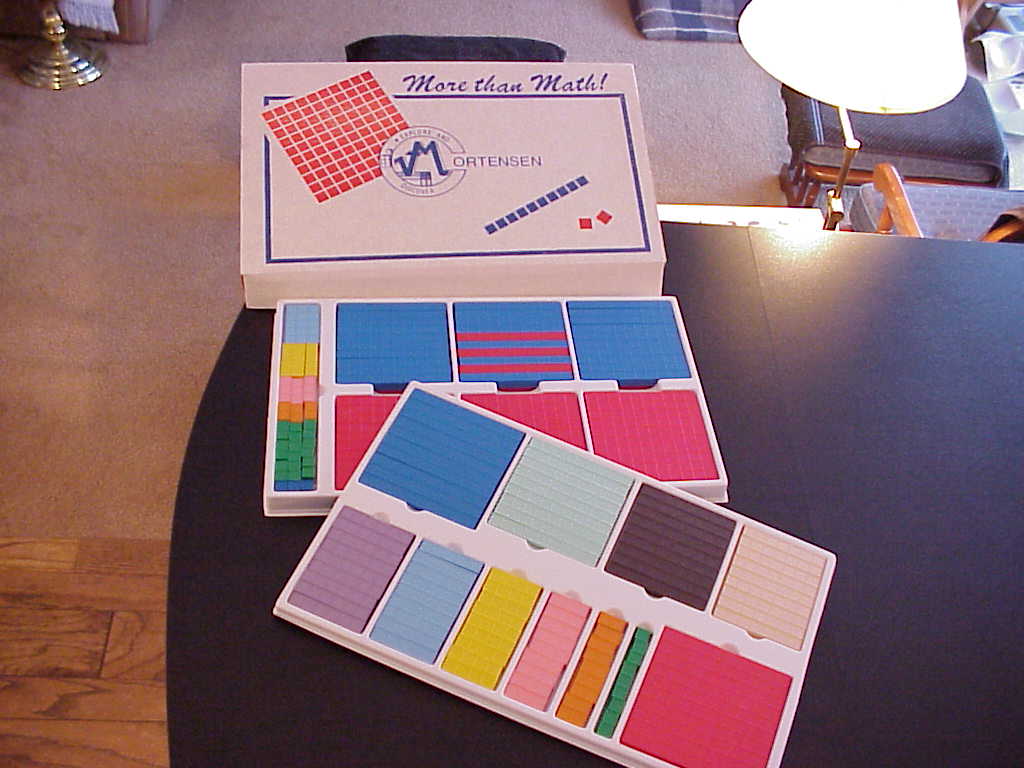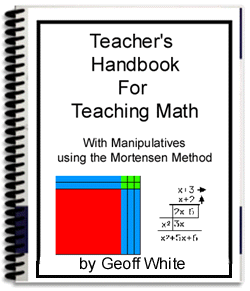The Grade 10 Math Crunch, or
Hitting the Wall at Grade 10
by Geoff White, B.Ed.
It is important that motivation to do math survives grade ten, survives high school in fact. But many students hit the wall at grade ten because that's where the rubber meets the road so to speak. That is when we finish teaching the basic skills of mathematics and the emphasis changes to doing story problems.
Up to grade ten the curriculum is designed to teach the operations of addition, subtraction, multiplication and division with whole numbers, fractions, decimals, and to teach basic algebra, as well as some geometry and trigonometry. Once this has been done the program shifts to solving problems told in story form where the student must understand the question told in words and supply the equation to solve the problem and to use the tools learned thus far to produce an answer.
This is where all the tool skills, reading for comprehension, abstract thinking and creative problem solving come together, and for many it is overwhelming. For many it is too much to try to do at once. Reading for information is necessary, as is thinking in abstract terms and also being creative in parsing the problem into parts to be done sequentially. The result is frustration and failure. Many students simply guess at an answer, or worse, cheat.
For those who cannot overcome the crunch of all these things coming together at once, when they realize that they did not really master any of the necessary skills along the ten year training path, they reject math altogether, saying simply, I am not "good at math." From that point on their career path is severely limited. Careers in Science, Technology, Engineering and Math (STEM) are not available. Passing high school math is a pre-requisite for University courses in those areas.
Life goes on. People still find work, get married, start families and have so on, but not at the same high level of success enjoyed by those who mastered the math - the engineers, biologists, doctors, architects, economists, actuaries, and so on.
For those who did not master the skills when they were first taught in grades one through ten but are determined to pass grade twelve say, it is a struggle, a costly challenge and even extra effort still may not be enough to enable the student to follow through at university level, so they settle for less, all because math success is denied them, apparently.
But is this necessary?
If mathematics is taught for the first ten years as memorizing facts, rules, formulae and process, depending on drill and rote memorization, regurgitating facts such as 3x9=27 so that they can be employed to do many, many, sums as practice before any understanding takes place, before abstract thinking develops in the pubescent child, then the grade ten math crunch is inevitable. The solution is simple: stop depending on memorization and start developing understanding.
How to do that? Easy. Teach mathematics the way we learn any other subject: Make it visual, make it concrete, not dependent on meaningless, abstract symbols, employ all the senses! Use manipulatives in creative, challenging ways so that number concepts can be acquired the way we learned relationships between people and things in the world. Create a math-rich environment the way we built a language-rich environment to teach other subjects. Emphasize understanding rather than memorizing algorithms to get answers. Enable success by breaking it down into parts that can be assimilated and accommodated at the child's level, then we can teach kindergarten calculus and factor polynomials before anyone can make them sound scary. Make it fun so that motivation is not destroyed before we even get to the exciting stuff. If math is such an important subject (and it is) why teach it in a way that is dependent on a child's weakest mental ability: memory, rather than her strongest mental ability: imagination?
Mortensen Math does all that. Devised by a Montessori teacher, trained in Italy, it is the only universal, comprehensive method extant in the world today. Others copy from MM, mimic it without grasping its fundamental principles, or they simply disregard important parts in order to sell their books and DVDs and tools and programs. All we do in math is count. See what one is. See all numbers as rectangles so that all operations are just building rectangles. All you need in order to do the math from K-12 is to know how to build rectangles and to count to nine.
Mortensen Math is being used in hundreds of Montessori and other schools, public and private, and by thousands of homeschoolers worldwide, since the 1980s. I personally have put it into use in Turkey, Malaysia, Singapore, the Philippines, South-West Africa, Papua & New Guinea, Australia, Hong Kong, Ireland, the UK, Holland, Canada and the USA, to name a few. The late Jerry Mortensen traveled far and wide in the years before the internet, teaching the method, showing teachers and parents everywhere that there is a better way. I have taught standing-room-only workshops at teacher's conventions in Canada and the USA and in Asia.
In 2018, I want to change the world. I want to change the way the world teaches math. I want to make it possible for more children to claim math as their favorite subject, and to be able to go on studying it after secondary school, after university, for the rest of their lives. Math is how we describe our world when words are not enough. Everyone deserves to speak math and to play math, to enjoy its beauty and its power. No citizenry can be manipulated by a demagogue if it has a visceral understanding of reality. Understanding math is essential to that.
Like eating any elephant, this must be done one bite at a time. I will need help. The internet and social media are being used to spread information to billions of people. The MM method is not something that can be acquired in 25 words or less, but the message can. I am trying to distill the wisdom of Montessori, Mortensen, Piaget, Cuisinaire, Euclid and all teachers that have gone before; the message is that mathematics is not restricted to special people who have that gene, but is available to anyone, of any gender or nation, dyslexic, blind or unchallenged, just by seeing all numbers as rectangles, learning to count to nine and so on, as mentioned above.
To start with, the method is king. Acquire the method, adopt the philosophy that all we do is count, and start seeing the world of numbers differently, not as abstract symbols but as concrete things. The rectangle is not only a Platonic ideal found just in that special realm, it is also a concrete thing you can hold in your hand and play with on a table using plastic blocks or tiles made of cardboard. The Complete Method is a .pdf that I wrote to make this accessible to anyone who wants to teach their children. The Teacher's Handbook includes that, and also has appendices on addition, subtraction, counting & games, multiplication, division, fractions, algebra, solving equations, functions & relations, story problems - fully illustrated in color. 250 pages, 8.5x11 also in .pdf form, it lays out exactly how to use manipulatives to teach K-12 mathematics. No memorization required. There are free videos on youtube also, just search Mortensen Math. Buy the Complete Method, or The Teacher's Handbook at www.geoffwhite.ws
and get it by e-mail, the same day!
The Mortensen Math program includes exercise books, 300 in all, from pre-school to grade 12,
teacher's manuals explaining every example in the first 3 levels, up to grade 9, say. We teach
kindergarten calculus by breaking it down into parts easy enough for a child at that level
to understand. Also algebra is introduced from day one, because it need not be left until
post-puberty if it is made concrete, and that is what MM does. We use the manipulatives
and the Mortensen model to decode the mathematical language into a spatial reality that you
can access with your fingers and see how it works. That is why you won't see it on a computer
because to do that is to keep math in the virtual, abstract world, and that compounds the
difficulties for learners that MM was created to solve. See the pricelist and many illustrated
articles about the method on my webpage

Teacher's Handbook for Teaching Math with Manipulatives
- In use in schools and homes around the world: Canada, USA, UK, Eire, Holland, Belgium, Australia, New Zealand, Papua & New Guinea, Philippines, Taiwan, Malaysia, Singapore, Indonesia, Thailand, SW Africa, Mexico, to name a few where I have placed it personally.

Table of Contents The Premise The Five-Minute Overview of the Method Key Phrases in Mortensen Math Very Brief Summary of the Method Psychological Principles at Work Introduction - cont'd Create a Math-Rich Environment The Teacher's Role & Student Self-Esteem Six Key Ideas from Jerry Mortensen Appendices: Section One - Counting Section Two - Addition Section Three - Subtraction Section Four - Multiplication Section Five - Division Section Six - Fractions Section Seven - Algebra Section Eight - Solving Equations Section Nine - Functions & Relations Section Ten - Story Problems Section Eleven - Mortensen Math Program
& Materials P.240
NOW in .PDF format! No postage costs, instant delivery!
The Teacher's handbook, 250 pages, full color, $65 USD
or, section one - The Complete Method, 45 pages, only $25 USD
and upgrade later for only $40 more!
To order: send payment by Paypal to me at

Want to read more about Mortensen Math?
Read all about Mortensen Math here:
Read all about Mortensen Math here:
| Hitting the Wall - the Grade Ten Math Crunch
| Purchasing Dilemmas
| Products/Price List
| Method is King
| Comparing Manipulatives
| Understanding
| Acquiring Meaning
| The Chinese Room Argument
| Mental Images
| A Fractions Example
| Psychological Principles at Work
| Self-Esteem & the Teacher's Role
| Comparing Methods
| A Philosophy of Teaching Math
| Teaching Principles of Mortensen Math
| A Math-Rich Environment
| Making Math Cool
| Memorization Cannot Lead To Understanding
| My Blog
| Photo Album
| Gallery
| Contact
| Home
Also: many free videos can be found on Youtube